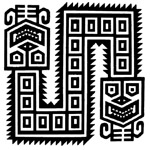Center, Textile Research

PreColumbian Textile Conference VII / Jornadas de Textiles PreColombinos VII (2016)
Date of this Version
11-13-2017
Document Type
Article
Citation
In PreColumbian Textile Conference VII / Jornadas de Textiles PreColombinos VII, ed. Lena Bjerregaard and Ann Peters (Lincoln, NE: Zea Books, 2017), pp. 398–404
doi:10.13014/K21N7Z96
Abstract
Gothenburg City has in its collection, 2000-year-old textiles from the Paracas peninsula in Peru. After the exhibition ”A Stolen World” at the National Museums of World Culture in 2008, Peru asked for a repatriation of the collection. Following negotiations between the City of Gothenburg and the Ministry of Culture in Peru it was decided that the ownership of the textiles would be returned to Peru. In June 2014, the first four textiles were returned to the National Museum of Archaeology, Anthropology, and History (MNAAHP) in Lima as a start of the repatriation. This was also the beginning of a collaboration with the shared objectives to learn more about physical conditions of the Paracas textiles collections in Peru and Sweden. In September 2015, the textile conservator returned to MNAAHP to examine the physical condition of the textiles after more than a year of acclimatization to the new museum environment. The investigations into the condition of the collection were undertaken by the textile conservator, as a visiting fellow, at the Heritage Laboratory of the Swedish National Heritage Board along with chemist Kaj Thuresson. Several analytical techniques were employed for the study: fibre documentation, optical microscopy, SEM, compression testing and pH measurements.
Análisis del material de fibra de Paracas de la colección de Gotemburgo
La Ciudad de Gothenburg tiene en su colección un grupo de textiles de 2000 años de antigüedad, procedentes de la península de Paracas en Perú. Después de realizarse la exhibición “Un Mundo Robado” en los Museo Nacionales de la Cultura Mundial en 2008, Perú pidió la repatriación de la colección. Luego de las negociaciones entre la Ciudad de Gothenburg y el Ministerio de Cultura del Perú, se decidió entregar los textiles al estado peruano. En Junio de 2014, los primeros cuatro textiles fueron enviados al Museo Nacional de Arqueología, Antropología e Historia del Perú (MNAAHP) en Lima, dando inicio al proceso de repatriación. También se inició una colaboración con el objetivo compartido de aprender más acerca de las condiciones físicas de las colecciones de textiles de Paracas en el Perú y en la Suecia. En setiembre de 2015, la conservadora textil volvió al MNAAHP para examinar la condición física de los textiles después de más de un año de ajuste al nuevo ambiente museológico. Las investigaciones acerca de la condición de la colección fueron realizados por esta conservadora textil, como investigadora visitante en el Laboratorio de Patrimonio del Patronato de Patrimonio Nacional de Suecia, junto con el químico Kaj Thuresson. Varias técnicas analíticas fueron empleados en el estudio: documentación de fibras, microscopía óptica, microscopía electrónica SEM, prueba de resistencia a la compresión y medición del pH.
Included in
Art and Materials Conservation Commons, Chicana/o Studies Commons, Fiber, Textile, and Weaving Arts Commons, Indigenous Studies Commons, Latina/o Studies Commons, Museum Studies Commons, Other History of Art, Architecture, and Archaeology Commons, Other Languages, Societies, and Cultures Commons


Comments
Copyright © 2017 by the author.